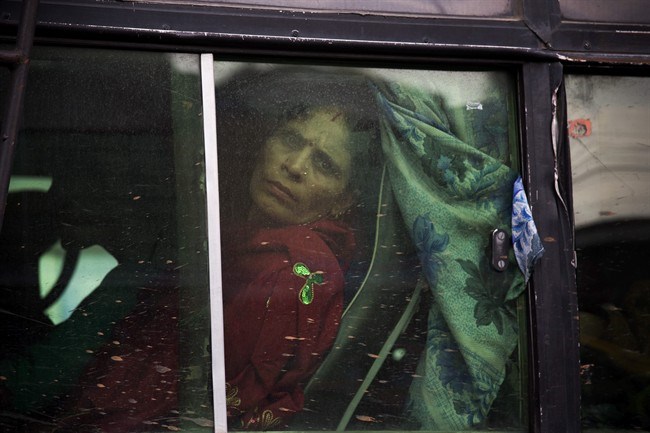
A Nepalese woman looks out from a bus leaving Kathmandu, Nepal, Wednesday, April 29, 2015. Thousands of people are lining up at bus stations in Kathmandu where the government is providing free transportation for people hoping to travel to their hometowns and villages. (AP Photo/Bernat Amangue)
Republished April 29, 2015 - 11:15 PM
Original Publication Date April 29, 2015 - 12:15 AM
KATHMANDU, Nepal - Under a steady morning drizzle, hundreds of people lined up Thursday in Kathmandu hoping to board free government-provided buses to rural parts of the quake-hit country as food aid began to reach remote villages near the epicenter.
Tens of thousands of people have left the capital since Monday to check on relatives in rural areas or simply to get away from the aftershocks that have rattled the city since Saturday's magnitude-7.8 quake. The disaster killed more than 5,500 people and rendered thousands more homeless.
"I have to get home. It has already been so many days," said Shanti Kumari, with her 7-year-old daughter, who was desperate to check on relatives in her home village in eastern Nepal. "I want to get at least a night of peace."
Five days after the quake, tent cities in Kathmandu had thinned out, as overnight rainfall persuaded many people to return to their homes, even if they were damaged by the quake. The streets of the capital were slick with rain Thursday morning, the potholes were filled with water.
While residents remained on edge, life in the capital was slowly returning to the way it had been before the quake. Small snack shops were open. At a leather goods shop, a merchant brushed dust from a jacket on display. A man laid out carpets and rugs beneath an awning at a handicrafts store. Foreigners stood in line at a cellphone store.
"It's getting back to normal, but we're still feeling aftershocks. It still doesn't feel safe," said Prabhu Dutta, a 27-year-old banker from Kathmandu. He said he felt four aftershocks in the morning, including one that rattled the sliding glass doors of the bookshelf in his bedroom —"My morning wakeup notice," he said.
Dutta has been sleeping in his home, which has some cracks in the wall, for two nights, but the dozens of small aftershocks that he has felt since Saturday's huge quake make him uneasy. "I am worried about whether they will continue for a long time or whether it will calm down."
He said some people are returning to work, including at his bank, "but we can't concentrate. We roam around the office. We only have one topic of conversation: the earthquake."
Many people in Kathmandu are going to the country fearing that a big aftershock is coming, he said. "They are afraid; everyone is afraid because the earthquakes haven't stopped fully."
On Wednesday, helicopters finally brought food, temporary shelter and other aid to villages northwest of Kathmandu in the mountainous Gorkha District near the epicenter. Entire clusters of homes there were reduced to piles of stone and splintered wood. Women greeted the delivery with repeated cries of "We are hungry!"
While the death toll in the village of Gumda was low — only five people were killed and 20 were injured among 1,300 residents — most had lost their homes and desperately needed temporary shelter, along with the 40-kilogram (90-pound) sacks of rice that were delivered Wednesday.
Meanwhile, at least 210 foreign trekkers and residents stranded in the Langtang area north of Kathmandu had been rescued, government administrator Gautam Rimal said. The area, which borders Tibet, is popular with tourists.
President Barack Obama called Prime Minister Sushil Koirala and discussed U.S. military and civilian efforts already underway to help Nepal, the White House said.
The U.N. World Food Program warned that it will take time for food and other supplies to reach more remote communities that have been cut off by landslides.
"More helicopters, more personnel and certainly more relief supplies, including medical teams, shelter, tents, water and sanitation and food, are obviously needed," said the program's Geoff Pinnock, who was co-ordinating the flights.
Police said the official death toll in Nepal had reached 5,489 as of late Wednesday. That figure did not include the 19 people killed at Mount Everest — five foreign climbers and 14 Nepalese Sherpa guides — when the quake unleashed an avalanche at base camp.
Dutta, the banker, said that while many of Kathmandu's cement and concrete buildings survived with only minor damage, many of the older buildings, ones made of tile or wood or bricks, have been levelled.
"Things have to return to normal, but it will take time," he said. "No one is ready to do the work needed to recover because of the closeness of the deaths. There is still shock."
___
Associated Press writer Katy Daigle reported from Gumda, Nepal.
News from © The Associated Press, 2015